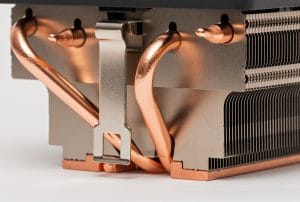 Since companies first began utilizing technology, the need to keep that technology properly cooled has been a significant concern. In more recent decades, they’ve benefited significantly from the advancement of thermal management techniques, including the natural heat transfer principles utilized by many modern heat exchangers. As the importance and variety of roles of electrical thermal management have expanded over the decades, so have the different ways in which companies can streamline their thermal management processes to create more efficient and eco-friendly electrical cooling results.
Since companies first began utilizing technology, the need to keep that technology properly cooled has been a significant concern. In more recent decades, they’ve benefited significantly from the advancement of thermal management techniques, including the natural heat transfer principles utilized by many modern heat exchangers. As the importance and variety of roles of electrical thermal management have expanded over the decades, so have the different ways in which companies can streamline their thermal management processes to create more efficient and eco-friendly electrical cooling results.
When it means cooling electrical enclosures
The need to keep electrical control panels and other enclosures properly cooled is one of the oldest and most common forms of electrical thermal management. In most forms of technology, such enclosures are what keep sensitive electrical components safe from contaminants in the environment. However, they also create enclosed spaces where the waste heat from these components can also create potentially harmful heat pockets that must be dealt with accordingly. Rather than relying on air conditioners or air compressors to keep these enclosures cool, more companies are choosing heat exchangers to streamline the process by continuously transferring waste heat away from sensitive components.
When it requires an eco-friendly approach
Heat exchangers are designed to cool electrical enclosures using natural heat transfer principles such as natural/forced convection, conduction, and phase-change cooling. Because they transfer heat instead of generating chilled air, heat exchangers help make cooling these enclosures a more efficient process. They also make electrical thermal management more eco-friendly overall in several important ways. On one hand, the process of transferring waste heat with an eco-friendly cooling fluid uses significantly less energy than more traditional thermal management methods, which helps lower a company’s overall energy usage. Heat exchangers also utilize eco-friendly cooling fluids, such as water, and create self-contained heat transfer loops, reducing the risks of leaks and eliminating the chances of releasing harmful substances into the environment.
When below-ambient cooling is necessary
By transferring waste heat from within electrical enclosures, heat exchangers are designed to keep the temperatures within the enclosures at just above the ambient temperatures outside of them. For some applications, however, effective thermal management requires below-ambient cooling to lower these temperatures below the ambient temperatures outside of the enclosures. Modern heat exchangers can also be designed to achieve these below-ambient cooling results to help companies further reduce their reliance on more costly thermal management solutions. For more information about what it means to streamline electrical thermal management, call Noren Thermal Solutions in Taylor, TX, at 866-936-6736.







